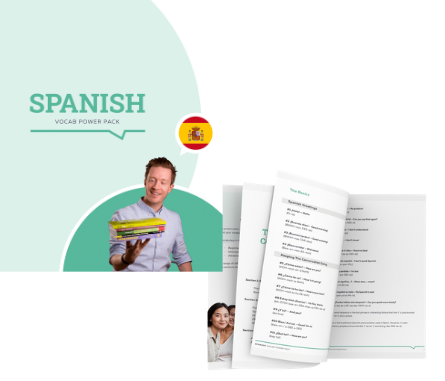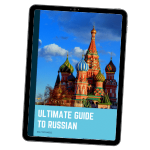
Have you always dreamt about learning Italian?
Perhaps you're fascinated by Italian culture. Or Italian people and their way of life.
In order to get started and have your first basic Italian conversations, you’re going to need to learn your first words!
In this post, you’ll learn 83 basic Italian phrases to help you have your first interactions in the language.
To make it easier for you, I’ve divided the phrases up into different categories based on the different situations they’re used in:
Table of Contents
Note: Want to go beyond basic Italian phrases and learn Italian with confidence and fluency? The best way to do so is by working through a comprehensive and well designed course. My top recommendation is Italian Uncovered, my in-depth online Italian course for beginners that teaches you through StoryLearning®. Click here for your free trial.
Anyway, back to our basic Italian phrases…. let's discover what they are!

Why Learn Italian Phrases?
In certain parts of Italy, chances are you’ll find some of the locals can speak good English. In big cities like Rome and Venice, the tourist industy is well developed and for locals working there speaking English is a must!
But as soon as you go off the beaten track, you’ll find that a little Italian goes a long way! In smaller towns, many people speak little or no English, so being able to get by in Italian makes a huge difference.
Get to grips with the basic Italian phrases in this post and you'll be able to have much more enjoyable and authentic experiences in Italy.
And even at home, learning Italian will allow you to discover more about the country's culture and history.
You don’t need to have a natural flair for languages. Learning a few key Italian sentences and a willingness to speak the language is all you need.
You never know, maybe learning these basic Italian phrases will motivate you to go on and become fluent in Italian.

To make it as easy as possible for you to practice these phrases in your Italian conversations, I’ve created an audio of the phrases and a special PDF version of this article to save on your phone to listen to and read anywhere, anytime and practice your Italian.
Click here to grab your copy now. (It's FREE!)
Note: The anglicised pronunciation listed for each phrase is approximate. There are certain aspects of Italian pronunciation (such as the double consonant sounds, for example) which are unique sounds not common in English. In order to get a clear understanding of how each of the words and phrases in this post are pronounced, I’ve created a set of free audio files to accompany the post. To download these for free, just click here.
Simple Italian Greetings

The first thing you need to learn to do in any language is to meet and greet people!
After all, you’re going to be using Italian greetings every time you have a conversation in Italian!
These basic Italian phrases are simple, easy to remember and will go a long way to help you make friends and have your first conversations in the language.
- #1 Ciao! – Hello/Goodbye (informal)
- (chow)
- #2 Salve! – Hello [any time of day]
- (sal-vay)
- #3 Salve, come va? – Hello, how are you?
- (sal-vay ko-may va?)
- #4 Buongiorno – Good morning
- (bu-on-jour-no)
- #5 Buon pomeriggio – Good afternoon
- (bu-on po-mer-eej-jio)
- #6 Buonasera – Good evening
- (bu-on-a-say-ra)
- #7 Buonanotte – Good night
- (bu-ona-not-tay)
- #8 Grazie mille – Thank you very much
- (gra-tsee mee-lay)
- #9 Grazie a Lei – Thank you, too [in reply to “thank you” from someone else]
- (gra-tsee a lay)
- #10 Arrivederci, alla prossima – Goodbye, see you next time
- (arr-ee-va-der-chee al-la pros-see-ma)
- #11 Bella giornata oggi, vero? – The weather is lovely today, isn’t it?
- (bella jee-or-na-ta ojji vay-ro?)
- #12 Mi chiamo… – My name is _
- (mee kee-amo)
- #13 Sono americano/canadese/inglese – I’m American/Canadian/English
- (so-no am-er-ee-kah-no / kan-a-day-say / een-glay-say)
- #14 Lei di dov'è? – Where are you from?
- (lay dee do-vay?)
- #15 Piacere – Nice to meet you
- (pee-a-chay-ray)
- #16 Mi sto divertendo molto – I’m having a great time!
- (mee sto dee-ver-ten-do mol-to)

Italian Vocabulary To Say “I Don't Understand”
As a beginner, there will be many moments when you get stuck and can't understand what people are saying to you in Italian.
When this happens, don't worry! It's a perfectly normal part of the learning process and in time, you'll begin to understand more and more of what you hear.
In the meantime, the key is know how to handle these situations when you can't understand. Let's learn a few simple Italian phrases that will allow you to remain in control of the situation even if you don't know what's being said to you.
- #17 Mi scusi, non capisco – I don't understand!
- (mee scoo-see non ka-pee-sko)
- #18 Non parlo italiano molto bene – I don’t speak Italian very well
- (non par-lo ital-ee-ah-no mol-to beh-nay)
- #19 Potrebbe ripetere, per favore? – Could you say that again please?
- (po-tre-bay ree-peh-teh-reh per fa-vawr-ay)
- #20 Potrebbe scrivermelo? – Please write that down for me
- (po-tre-bay skree-ver-may-lo?)
- #21 Cosa vuole dire? – What does that mean?
- (ko-sa vu-ol-ay dee-ray?)

Note:
- Cosa vuol dire questo/quello? = “What does this mean?”, when showing something written
We don't say cosa vuol dire quello? implying something the other person said. We just say Cosa vuole dire? = “what do you mean by that?”
- #22 Parla inglese? – Do you speak English?
- (par-la een-glay-say?)
- #23 Mi scusi – I’m sorry
- (mee skoo-see)
- #24 Non lo so – I don’t know
- (non lo so)
- #25 Va bene – All right
- (va be-nay)
- #26 Non importa – Never mind
- (non eem-por-ta)
Numbers In Italian

Whether you're ordering drinks, paying a bill or buying a train ticket, numbers are something you'll need to be familiar with in Italian right from the beginning.
The good news is that Italian numbers are pretty logical and straightforward. Once you learn 1-20, the rest just follow on from there!
- uno – one
- (oo-no)
- due – two
- (doo-ay)
- tre – three
- (tray)
- quattro – four
- (kwat-ro)
- cinque – five
- (chee-kway)
- sei – six
- (say)
- sette – seven
- (say-tay)
- otto – eight
- (ot-to)
- nove – nine
- (no-vay)
- dieci – ten
- (dee-ay-chee)
- undici – eleven
- (oon-dee-chee)
- dodici – twelve
- (do-dee-chee)
- tredici – thirteen
- (tray-dee-chee)
- quattordici – fourteen
- (kwa-tor-dee-chee)
- quindici – fifteen
- (kween-dee-chee)
- sedici – sixteen
- (say-dee-chee)
- diciassette – seventeen
- (dee-chee-a-set-tay)
- diciotto – eighteen
- (dee-chee-ot-to)
- diciannove – nineteen
- (dee-chee-no-vay)
- venti – twenty
- (ven-tee)
- ventuno – twenty-one
- (ven-too-no)
- ventidue – twenty-two
- (ven-tee-doo-ay)
- trenta – thirty
- (tren-ta)
- quaranta – forty
- (kwa-ran-ta)
- cinquanta – fifty
- (cheen-kwan-ta)
- sessanta – sixty
- (ses-san-ta)
- settanta – seventy
- (se-ten-ta)
- ottanta – eighty
- (o-tan-ta)
- novanta – ninety
- (no-van-ta)
- cento – one hundred
- (chen-to)
- duecentocinquanta – two hundred and fifty
- (doo-ay-chen-to-cheen-kwan-ta)
- cinquecento – five hundred
- (cheen-kway-chen-to)
- settecento ottantatré – seven hundred and eighty three
- (set-tay-chen-to ot-tan-ta-tray)
- mille – one thousand
- (mee-lay)
Italian Expressions To Use At The Restaurant

Arguably one of the most motivating reasons to learn Italian is to explore the country's cuisine!
Italian food is famous the world over and with good reason! These next few basic Italian phrases will help you get by in restaurants so you can try out some of those delicious Italian recipes.

- #27 Un tavolo per uno / due, per favore – A table for one / two please
- (oon ta-vo-lo per oo=no / doo-ay, per fa-vo-ray?)
- #28 Siete già aperti? – Are you open yet?
- (see-et-ay jee-ah a-per-tee?)
- #29 Possiamo aspettare (per un tavolo)? – Can we wait (for a table)?
- (poss-ee-amo as-pett-ah-ray per oon ta-va-lo?)
- #30 Possiamo sederci laggiù? – Can we sit over there?
- (poss-ee-amo se-der-chee la-jee-oo)
- #31 Mi scusi! – Excuse me! [Calling a waiter]
- (mee skoo-see)
- #32 Cosa mi consiglia? – What do you recommend?
- (ko-sa mee kon-sihl-ya?)
- #33 Qual è la specialità della casa? – What’s your most popular dish?
- (Kwal e la spe-chee-a-lee-tay de-la ka-sa?)
- #34 Cos'è questo? – What’s this?
- (ko-say kwes-to?)
- #35 Mi farebbe un assortimento dei piatti migliori? – Please bring me a selection of nice things
- (mee fa-ray-bay un a-sor-tee-men-to day pee-a-tee mil-yor-ee?)
- #36 Faccia Lei! / Lascio decidere a Lei. – It’s up to you/You can decide
- (fach-ee-a lay! / las-chee-o de-chee-day-ray a lay)
- #37 Il conto, per favore – The cheque, please
- (il kon-to, per fa-vor-ay)
- #38 Potrei avere il menu, per favore? – Can I have the menu, please?
- pot-ray a-vay-ray eel me-noo, per fa-vo-ray?)
Transport In Italy

If you're planning a trip to Italy, you're probably going to need public transport to get around. These basic Italian phrases will help you to buy tickets and find your destinations easily.
- #39 Vorrei andare a ___ – I want to go to _
- (vo-ray an-da-ray a _)
- #40 A che ora parte il prossimo treno/autobus per ___? What time is the next train/bus to _ ?
- (a kay oh-ra par-tay eel pros-see-mo tray-no / auw-to-boos per _?)
- #41 Quanto costa? – How much is it?
- (kwan-to kos-ta?)
- #42 1 biglietto / 2 biglietti (per ___, per favore – 1 ticket / 2 tickets (to _), please
- (oon bil-yeto / doo-ah bil-yetti per _, per fa-vo-ray)
- #43 Quanto dura il viaggio? – How long does it take?
- (kwan-to doo-ra eel vi-ahj-o)
- #44 Dove devo andare adesso? – Where should I go now?
- (do-vay day-vo an-da-ray a-day-sso?)
- #45 Quando parte? – When does it leave?
- (kwan-do par-tay?)
- #46 Che ore sono (adesso)? – What time is it (now)?
- (kay ora so-no a-day-sso?)
- #47 Questo treno/autobus ferma a ___? – Does this train/bus stop in _?
- (kwes-to tray-no / auw-to-boos fer-ma a _?)
- #48 Mi scusi, è qui ___? – Excuse me, is this _? [Useful when you’re on the bus/train and aren’t sure when to get off]
- (mee skoo-see, ee kwee _?)
- #49 Dove si trova ___ sulla carta? – Where is _ on the map?
- (do-vay see tro-va _ soo-la kar-ta?)
Asking For Directions In Italian

Exploring new places is exciting, but it can also be frustrating when you find yourself lost! But fear not, by learning to say and understand the following basic Italian phrases, you'll be able to ask for and receive directions from the locals.
- #50 Mi scusi, posso farle una domanda? – Excuse me, could I ask you something?
- (mee skoo-si, posso far-lay oo-na do-man-da?)
- #51 Vorrei andare a ___ – I want to go to _ [If you know the name of your destination]
- (vo-ray an-da-ray a _)
- #52 Vorrei andare qui – I want to go here [Pointing to your destination on the map]
- (vo-ray an-da-ray kwee)
- #53 Mi sono perso / Mi sono persa – I’m lost
- (mee so-no per-so / mee so-no per-sa)
- #54 Come posso arrivarci? – How can I get there?
- (ko-mo pos-so a-rree-var-chee?)
- #55 È di qua? – Is it this way? [Useful for checking if you’re walking in the right direction]
- (ay dee kwa?)
- #56 Potrebbe indicarmelo sulla carta? – Can you show me on the map?
- (po-tray-bay een-di-kar-may-lo soo-la kar-ta?)
- #57 Dov'è ___? – Where is _ ?
- (do-vay _?)
Shopping In Italy

Whether in the supermarket, the shopping centre or the local farmer’s market you’re going to want to buy things at some point or another!
To do this, you need to be able to ask questions [or even haggle a bit!] just like you would in English! Here are the Italian phrases you'll need:
- #58 Mi piace questo – I like this
- (mee pee-a-chay kwes-to)
- #59 Quanto costa questo? – How much is this?
- (kwan-to kos-ta kwes-to?)
- #60 Se li compro entrambi? – If I buy these together? [A useful way to knock the price down]
- (see lee com-pro en-tram-bee?)
Note:
li means “them” for masculine nouns. It is OK to use it with two masculine nouns or a mix of feminine and masculine nouns, but when referring to two feminine nouns le should be used instead
- #61 È troppo caro per me – It’s too expensive for me
- (ay troh-poh ca-roh per may)
- #62 Può farmi uno sconto? – Can you do me a discount?
- (poo-o far-mee oo-no skon-to?)
- #63 Cerco una ___ – I’m looking for a _
- (cher-ko oo-na _)
- #64 Sto solo guardando – I’m just looking around
- (Sto so-lo gwar-dan-do)
- #65 Grazie, continuo a guardare – Thank you, I’ll keep looking [when you’re getting hassle to buy something]
- (gra-tsee, kon-tee-noo-o a gwar-da-ray)
- #66 Un attimo – Just a moment
- (oon attee-mo)
- #67 Sì, grazie – Yes, please
- (see, gra-tsee)
- #68 No, grazie – No, thanks
- (no, gra-tsee)
Dealing With Medical Emergencies In Italian

Hopefully, you’ll never need the phrases in this section! Nonetheless, it’s always good to know some basic medical vocabulary so that can handle an emergency in case you get sick or suffer an accident.
- #69 Può aiutarmi, per favore? – Can you help me, please?
- (poo-o ay-oo-tar-mee, per fa-vo-ray?)
- #70 Devo andare da un medico – I need to see a doctor
- (de-vo an-day-ray da oon me-dee-ko)
- #71 Non mi sento bene – I don’t feel well
- (non mee sen-to bay-nay)
- #72 Non si sente bene – He/she doesn’t feel well
- (non see sen-tay bay-nay)
- #73 C'è un ospedale da queste parti? – Is there a hospital near here?
- (chay oon os-pay-da-lay da kwes-tay par-tee)
- #74 Mi porti in ospedale, per favore – Take me to the hospital please [To a taxi driver]
- (mee por-tee in os-pay-da-lay, per fa-vo-ray)
- #75 Mi fa male qui – It hurts here [pointing to body part]
- (mee fa ma-lay kwee)
- #76 Ho bisogno di medicine – I need some medicine
- (o bi-son-yo dee me-dee-cee-nay)
Finding Hidden Gems & Other Places In Italy

Finally, let's learn some simple phrases that will help you discover the hidden gems on your next trip to Italy! Locals are always keen to share their favourite restuarants and cafes with visitors, but if you want to find out about them you need to know how to ask!
- #77 Mi scusi, ma… – I’m sorry to bother you, but…
- (mee skoo-see ma)
- #78 Posso farle una domanda? – Could I ask you something quickly?
- (posso far-lay oo-na do-man-da?)
- #79 Cerco un posto qui in zona dove si mangi bene – I’m looking for a place with good food around here
- (cher-ko oon pos-to kwee in zo-na do-vay see man-gee bay-nay)
- #80 Cerco un bar carino qui in zona – I’m looking for a nice cafe in the area
- (cher-ko oon bar kar-ee-no kwee in zo-na)
- #81 Ne conosce qualcuno? – Do you know anyone [here]?
- (nay kon-os-chay kwal-koo-no?)
- #82 C'è qualche posto interessante da visitare qui in zona? – Is there anything interesting to see in this area?
- (chay qual-kay pos-to in-ter-es-san-tay da vee-see-ta-ray kwee in zo-na?)
- #83 Grazie comunque – Thank you, anyway [if they can’t help you]
- (grat-see ko-moon-kway)

Basic Italian Phrases FAQ
What Is A Common Italian Phrase?
A common Italian phrase is Come stai? (How are you?), often used in casual conversations. Another frequent expression is Va bene (It’s okay/All good).
What Italian Words Should I Learn First?
Start with essential words like ciao (hello), grazie (thank you), per favore (please), sì (yes), no (no), scusa (excuse me/sorry), and numbers from 1 to 10. Learning basic verbs like essere (to be) and avere (to have) is also helpful.
What Do Italians Say Often?
Italians frequently say prego (you’re welcome), ciao (hello/goodbye), and buongiorno (good morning). They also often use allora (so, well) to start sentences or connect thoughts.
What Is The Basic Greeting In Italy?
The basic greeting is ciao, which means both hello and goodbye in informal settings. For more formal occasions, use buongiorno (good morning) or buonasera (good evening).
Your Next Steps In Italian

So there you have it: all of the basic Italian phrases you need to help you discover and start using the Italian language.
With these phrases in your back pocket, you will soon find yourself having your first basic conversations with native speakers and getting excited about developing your conversational Italian.
So now that you’ve learned the basics, are you ready to take the next step in your Italian adventure?
I'm a big believer in the power of StoryLearning® to enable you to learn a foreign language. That's why I've created an entire beginner course dedicated to learning Italian by immersing yourself in an engaging story.
It's my Italian Uncovered course, and it's designed to take you from beginner to B1 Intermediate level. Find out more and try out the method for free.

Olly Richards
Creator of the StoryLearning® Method
Olly Richards is a renowned polyglot and language learning expert with over 15 years of experience teaching millions through his innovative StoryLearning® method. He is the creator of StoryLearning, one of the world's largest language learning blogs with 500,000+ monthly readers.
Olly has authored 30+ language learning books and courses, including the bestselling "Short Stories" series published by Teach Yourself.
When not developing new teaching methods, Richards practices what he preaches—he speaks 8 languages fluently and continues learning new ones through his own methodology.










































